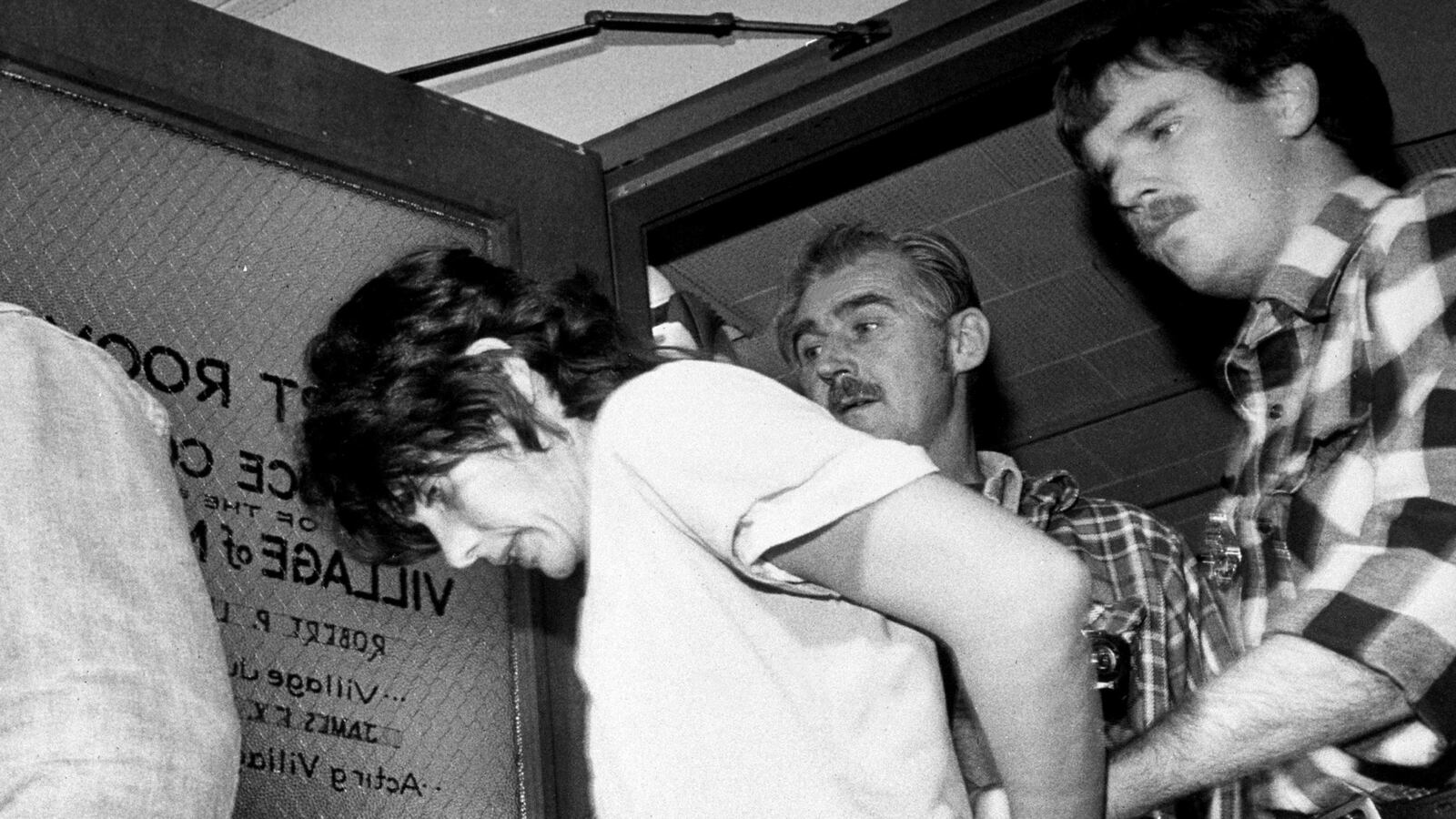Last week, Rutgers University fired its mercurial basketball coach after he was videotaped “shoving, grabbing and throwing balls at players in practice and using gay slurs,” according to ESPN. Under pressure from school administrators, Rutgers’ athletic director, who had previously defended the coach’s behavior, resigned. It was an appropriate response: violent oafs should be fired from their university jobs for violent, oafish behavior.

On the same day ESPN broadcast the Rutgers tape, The New York Post reported that Kathy Boudin, a professor at Columbia University, was named the 2013 Sheinberg Scholar-in-Residence at NYU Law School. In 1984, Boudin, a member of the Weather Underground, a violent, oafish association of upper-class “revolutionaries,” pled guilty to second-degree murder in association with the infamous 1981 Brinks armored car robbery in Nyack, New York. Babbling in the language of anti-racism and anti-imperialism, Boudin assisted in ending the life of three people, including Waverly Brown, the first black police officer on the Nyack police force, and left nine children fatherless. She was sentenced to 20 years to life in prison. In 2003, Boudin was released; by 2008 she had landed a coveted teaching position at an Ivy League university.
Indeed, Boudin’s Columbia University biography doesn’t mention her violent past, describing her simply as “an educator and counselor with experience in program development since 1964, working within communities with limited resources to solve social problems.” Neither does an official NYU press release announcing her new gig, instead explaining that Boudin “has been dedicated to community involvement in social change since the 1960’s.” Well, that’s one way of putting it. (Boudin didn’t respond to an interview request.)
Kick a student on the basketball court and you’ll lose your university job. Spend two decades in prison on radical chic murder rap and you’ll get one.
Let’s be clear: Private colleges can hire whomever they like, though one suspects that a Pinochet loyalist, a propagandist for Franco, or a far-right bomber—where academic jobs are scarce—wouldn’t make the shortlist of candidates at Columbia or NYU. In fact, there is a rather ignoble tradition within academia of welcoming those with fringe views and violent backgrounds, provided their politics were “misguided” in the appropriate direction.
The most famous Weather Underground bombers-cum-professors are, of course, Bill Ayers and Bernadine Dohrn (also a former Sheinberg Scholar-in-Residence at NYU, which must consider bomb-making skills when making its selection), whose infantile politics and tenure on the FBI’s Most Wanted List never dented the confidence of the University of Illinois or Northwestern University.
Ayers and Dohrn have long maintained that their bombing campaigns never deliberately targeted people, a claim that elides a rather important event: the famous 1970 explosion at a Weather bomb factory in New York City that killed three people, all of whom were constructing nail-packed pipe bombs for deployment at an army dance in Fort Dix, New Jersey. The goal was to blind, maim, and kill. Boudin was present, but escaped the explosion and evaded capture. She insisted during her 2003 parole hearing, against logic and and all available evidence, that she was unaware the house was being used to construct bombs.
In a fair-minded piece for LA Weekly, journalist Peter Jamison reported that investigators also believed an unsolved 1970 bombing of a San Francisco police station, which killed one officer and blinded another, could be tied back to Ayers and Dohrn. According to Jamison, “two credible eyewitnesses—both former left-wing radicals tied to the Weathermen—gave detailed statements to investigators in the 1970s alleging that Dohrn and Howard Machtinger, another member of the group, were personally involved in organizing the deadly attack.”

Ayers, Dohrn, and Machtiger spent most of the 1970s “underground,” attempting to avoid prosecution on a variety of charges (including a foiled attempt to bomb the Detroit Police Officers Association Building) and Jamison says that the three “were all targets of a secret federal grand jury investigation in 2003” into the police station bombing. It might not surprise you that, before retiring, Machtinger was a professor at North Carolina Central University and Teaching Fellows Director at University of North Carolina, Chapel Hill’s School of Education. According to Jamison, Ayers, Dohrn, and Machtiger all refused repeated requests to comment on the case.
Or take former Black Panther party grandee Ericka Huggins, who is now a professor of women’s studies at California State University, a professor of sociology at Laney and Berkeley City College, and, according to one official biography, a “human rights activist.” In 2011, students at the University of Kentucky could receive extra credit for attending a lecture by Huggins, described as a “political prisoner and human rights activist.” It does not seem to bother these universities that in 1970 Huggins was brought to trial on charges of “aiding and abetting” the murder of Alex Rackley, a fellow Panther they wrongly believed to be a police informant. She was acquitted.
But a few salient facts aren’t disputed: After days of “interrogation,” Rackley was brutally tortured—beaten mercilessly, boiling water poured on his naked body—and left to marinate in his own blood, urine, and feces. As a warning to other “traitors,” one torture session was audiotaped. In the scratchy recording recovered by police, Huggins can be heard recalling when she “began to realize how phony [Rackley] was and that he was either an extreme fool or a pig, so we began to ask questions with a little force and the answers came out after a few buckets of hot water.” During the session, Rackley was tied to his chair with a gun pointed at him. As he shifted nervously, Huggins snapped, “Sit down motherfucker. Keep still.” (A copy of the tape was recently discovered in a Connecticut house and can be listened to here).
In their book Murder in the Model City, authors Paul Bass and Douglas W. Rae describe a broken Rackley being led out of the house two days after the taped session, to be driven to his execution site in a nearby marsh: “From her perch by the kitchen counter, Ericka Huggins, the highest-ranking female Panther in town, watched [Panthers George] Sams and Warren [Kimbro] walk Rackley out the door. Sam brandished the .45 automatic as he held Rackley’s arms, which were tied together with ropes.” Warren Kimbro shot Alex Rackley in the head. He later confessed to the murder and was sentenced to life in prison, but only served four years. By 1975, he was an assistant dean at Eastern Connecticut State University.
After years on the run, having been indicted for her involvement in the Brinks robbery and murder in Nyack, Weather Underground member Susan Rosenberg was caught in 1985 moving “740 pounds of dynamite and weapons, including a submachine gun,” according to The New York Times, from her car into a storage locker. After 16 years in prison, her sentence was commuted by President Bill Clinton and, not long after, the self-identified “human rights activist” took a position teaching at John Jay College. After her contract wasn’t renewed, she found a perch at Hamilton College, though furious opposition by some faculty members forced the administration to withdraw the offer. But no hard feelings from the John Jay College of Criminal Justice Interdisciplinary Studies Program, which in 2011 invited students “to a celebration of Susan Rosenberg” upon the release of her memoir.
Former Weather Underground member Eleanor Raskin, who fled after being indicted for bomb making in the 1970s, is an associate professor at Albany Law School. In 1981, Raskin and her husband were arrested in connection with an explosives cache uncovered two years earlier by New Jersey police (her husband was placed on probation; the charges against Raskin were dropped). After years in hiding, Mark Rudd, a Weather leader who also fled indictment and went “underground,” turned himself in 1977 and was sentenced to two years’ probation. He later taught at Central New Mexico Community College.
And on it goes. Perhaps you detect a pattern developing here?
They might have been violent charlatans, but they were violent charlatans in search of a better society. They might resist providing a full and proper accounting of their crimes, but most will concede that their tactics might have been misguided and offer qualified repentance, but insist that their instincts were correct.
So go ahead and commit a crime, “expropriate” a bank. Just make sure you leave an incoherent manifesto at the scene, claiming that you’re shooting your guns and filling your pockets with loot for the people. When caught, you won’t be a convicted murderer, but a “political prisoner.” And when released, you can be a college professor.





